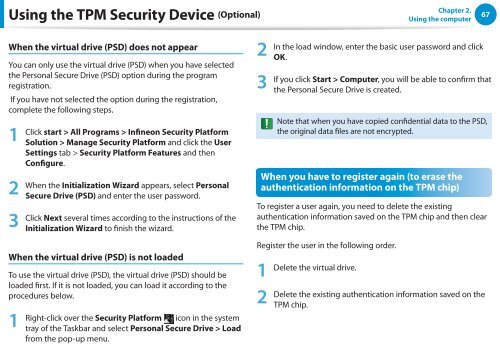Samsung ATIV Book 2 (15.6" HD / Pentium® Processor) - NP270E5E-K01US - User Manual (Windows 7) ver. 1.6 (ENGLISH,17.64 MB)
Samsung ATIV Book 2 (15.6" HD / Pentium® Processor) - NP270E5E-K01US - User Manual (Windows 7) ver. 1.6 (ENGLISH,17.64 MB)
Samsung ATIV Book 2 (15.6" HD / Pentium® Processor) - NP270E5E-K01US - User Manual (Windows 7) ver. 1.6 (ENGLISH,17.64 MB)
You also want an ePaper? Increase the reach of your titles
YUMPU automatically turns print PDFs into web optimized ePapers that Google loves.
Using the TPM Security Device (Optional)<br />
Chapter 2.<br />
Using the computer<br />
67<br />
When the virtual drive (PSD) does not appear<br />
You can only use the virtual drive (PSD) when you have selected<br />
the Personal Secure Drive (PSD) option during the program<br />
<strong>reg</strong>istration.<br />
If you have not selected the option during the <strong>reg</strong>istration,<br />
complete the following steps.<br />
1<br />
2<br />
3<br />
Click start > All Programs > Infineon Security Platform<br />
Solution > Manage Security Platform and click the <strong>User</strong><br />
Settings tab > Security Platform Features and then<br />
Configure.<br />
When the Initialization Wizard appears, select Personal<br />
Secure Drive (PSD) and enter the user password.<br />
Click Next se<strong>ver</strong>al times according to the instructions of the<br />
Initialization Wizard to finish the wizard.<br />
When the virtual drive (PSD) is not loaded<br />
To use the virtual drive (PSD), the virtual drive (PSD) should be<br />
loaded first. If it is not loaded, you can load it according to the<br />
procedures below.<br />
1<br />
Right-click o<strong>ver</strong> the Security Platform icon in the system<br />
tray of the Taskbar and select Personal Secure Drive > Load<br />
from the pop-up menu.<br />
2<br />
3<br />
In the load window, enter the basic user password and click<br />
OK.<br />
If you click Start > Computer, you will be able to confirm that<br />
the Personal Secure Drive is created.<br />
Note that when you have copied confidential data to the PSD,<br />
the original data files are not encrypted.<br />
When you have to <strong>reg</strong>ister again (to erase the<br />
authentication information on the TPM chip)<br />
To <strong>reg</strong>ister a user again, you need to delete the existing<br />
authentication information saved on the TPM chip and then clear<br />
the TPM chip.<br />
Register the user in the following order.<br />
1<br />
2<br />
Delete the virtual drive.<br />
Delete the existing authentication information saved on the<br />
TPM chip.
















